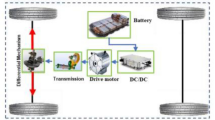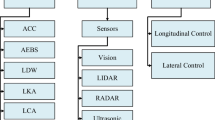Abstract
In this study, vehicle queuing was investigated at intersections to propose an eco-driving strategy to improve vehicle energy consumption and traffic efficiency in urban traffic environments. The proposed design approach can be applied to electric vehicles, and the control framework is categorized into two layers. In the upper layer, the speed of the host vehicle is planned offline, and in the lower layer, the required control variable acceleration is determined. First, the energy optimization problem of electric vehicles passing through an intersection was constructed, and the planning vehicle speed was obtained based on the genetic algorithm (GA). Next, the speed tracking controller and distance tracking controller were designed using sliding mode control (SMC) to ensure that the vehicle can track the planning speed with safe vehicle spacing. Finally, combined with specific cases, the energy-saving effect of the proposed method in the single-vehicle scenario, and the presence of manual driving vehicles in front- and multi-vehicle driving scenarios were studied. The results revealed that the GA-based single-vehicle speed planning method reduced energy consumption by up to 16% compared with the rule-based speed planning method. Furthermore, compared with the intelligent driver model (IDM) and adaptive cruise control (ACC) methods, the GA fleet speed planning method based on V2X communication can reduce average fleet energy consumption by 26% and 24%, respectively, and improve intersection traffic efficiency. The results of the sensitivity analysis of factors affecting planned speed revealed that vehicles passing through intersections at a steady speed exhibited superior economic performance. Finally, hardware-in-the-loop (HIL) testing was performed to verify the effectiveness of the controller under real-time conditions.
Similar content being viewed by others
References
Feng Y, Yu C, Liu H X. Spatiotemporal intersection control in a connected and automated vehicle environment. Transp Res Part C, 2018, 89: 364–383
Pan C, Huang A, Chen L, et al. A review of the development trend of adaptive cruise control for ecological driving. Proc Instit Mech Eng Part D, 2022, 236: 1931–1948
Wang Q, Ju F, Zhuang W C, et al. Ecological cruising control of connected electric vehicle: A deep reinforcement learning approach. Sci China Tech Sci, 2022, 65: 529–540
Liu H, Wei H, Zuo T, et al. Fine-tuning ADAS algorithm parameters for optimizing traffic safety and mobility in connected vehicle environment. Transp Res Part C, 2017, 76: 132–149
Sun W, Zheng J, Liu H X. A capacity maximization scheme for intersection management with automated vehicles. Transp Res Part C-Emerging Technologies, 2018, 94: 19–31
Ma F, Yang Y, Wang J, et al. Eco-driving-based cooperative adaptive cruise control of connected vehicles platoon at signalized intersections. Transp Res Part D, 2021, 92: 102746
Vajedi M, Azad N L. Ecological adaptive cruise controller for plug-in hybrid electric vehicles using nonlinear model predictive control. IEEE Trans Intell Transp Syst, 2016, 17: 113–122
Zhou Y Z, Wang R C, Ding R K, et al. Investigation on hierarchical control for driving stability and safety of intelligent HEV during car-following and lane-change process. Sci China Tech Sci, 2021, 65: 53–76
Gao Z, LaClair T, Ou S, et al. Evaluation of electric vehicle component performance over eco-driving cycles. Energy, 2019, 172: 823–839
He X, Wu X. Eco-driving advisory strategies for a platoon of mixed gasoline and electric vehicles in a connected vehicle system. Transp Res Part D, 2018, 63: 907–922
HomChaudhuri B, Vahidi A, Pisu P. Fast model predictive control-based fuel efficient control strategy for a group of connected vehicles in urban road conditions. IEEE Trans Contr Syst Technol, 2017, 25: 760–767
Yang Y, Ma F, Wang J, et al. Cooperative ecological cruising using hierarchical control strategy with optimal sustainable performance for connected automated vehicles on varying road conditions. J Cleaner Prod, 2020, 275: 123056
Pan C, Huang A, Wang J, et al. Energy-optimal adaptive cruise control strategy for electric vehicles based on model predictive control. Energy, 2022, 241: 122793
Liu H, Lu X Y, Shladover S E. Traffic signal control by leveraging cooperative adaptive cruise control (CACC) vehicle platooning capabilities. Transp Res Part C, 2019, 104: 390–407
Xu B, Ban X J, Bian Y, et al. Cooperative method of traffic signal optimization and speed control of connected vehicles at isolated intersections. IEEE Trans Intell Transp Syst, 2019, 20: 1390–1403
Silgu M A, Erdağı İ G, Çelikoğlu H B. Network-wide emission effects of cooperative adaptive cruise control with signal control at intersections. Transp Res Procedia, 2020, 47: 545–552
Zhao J, Li W, Wang J, et al. Dynamic traffic signal timing optimization strategy incorporating various vehicle fuel consumption characteristics. IEEE Trans Veh Technol, 2016, 65: 3874–3887
Aziz H M A, Zhu F, Ukkusuri S V. Learning-based traffic signal control algorithms with neighborhood information sharing: An application for sustainable mobility. J Intel Transp Syst, 2018, 22: 40–52
Mandava S, Boriboonsomsin K, Barth M. Arterial velocity planning based on traffic signal information under light traffic conditions. In: The 12th International IEEE Conference on Intelligent Transportation Systems. St. Louis, 2009. 1–6
Jiang H, Hu J, An S, et al. Eco approaching at an isolated signalized intersection under partially connected and automated vehicles environment. Transp Res Part C, 2017, 79: 290–307
Kamalanathsharma R K, Rakha H A. Multi-stage dynamic programming algorithm for eco-speed control at traffic signalized intersections. In: 16th International IEEE Conference on Intelligent Transportation Systems. The Hague, 2013. 2094–2099
Lin Q, Li S E, Xu S, et al. Eco-driving operation of connected vehicle with V2I communication among multiple signalized intersections. IEEE Intell Transp Syst Mag, 2021, 13: 107–119
Tang X, Duan Z, Hu X, et al. Improving ride comfort and fuel economy of connected hybrid electric vehicles based on traffic signals and real road information. IEEE Trans Veh Technol, 2021, 70: 3101–3112
Liu B, Sun C, Wang B, et al. Adaptive speed planning of connected and automated vehicles using multi-light trained deep reinforcement learning. IEEE Trans Veh Technol, 2022, 71: 3533–3546
Lu Y, Xu X, Ding C, et al. A speed control method at successive signalized intersections under connected vehicles environment. IEEE Intell Transp Syst Mag, 2019, 11: 117–128
Chen Q, Zhao W, Li L, et al. ES-DQN: A learning method for vehicle intelligent speed control strategy under uncertain cut-in scenario. IEEE Trans Veh Technol, 2022, 71: 2472–2484
Li L, Zhao W, Wang C. POMDP motion planning algorithm based on multi-modal driving intention. IEEE Trans Intell Veh, 2023, 8: 1777–1786
Li L, Zhao W, Wang C, et al. BRAM-ED: Vehicle trajectory prediction considering the change of driving behavior. IEEE ASME Trans Mechatron, 2022, 27: 5690–5700
Lazar C, Tiganasu A, Caruntu C F. Arterial intersection improvement by using vehicle platooning and coordinated start. IFAC-PapersOnLine, 2018, 51: 136–141
Author information
Authors and Affiliations
Corresponding author
Additional information
This work was supported by the National Natural Science Foundation of China (Grant No. 52272367).
Rights and permissions
About this article
Cite this article
Pan, C., Li, Y., Huang, A. et al. Energy-optimized adaptive cruise control strategy design at intersection for electric vehicles based on speed planning. Sci. China Technol. Sci. 66, 3504–3521 (2023). https://doi.org/10.1007/s11431-023-2459-8
Received:
Accepted:
Published:
Issue Date:
DOI: https://doi.org/10.1007/s11431-023-2459-8




